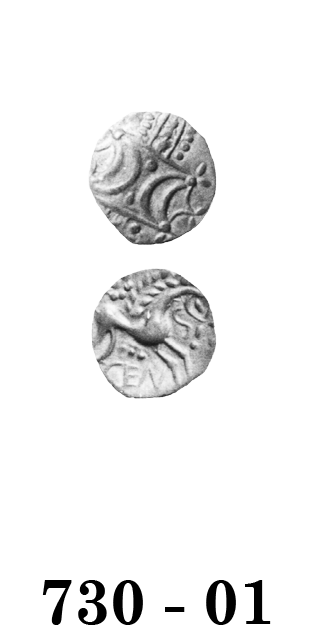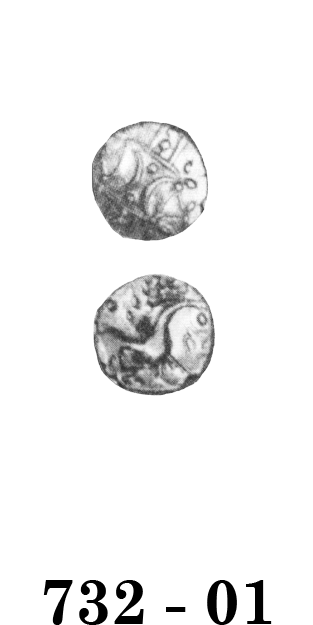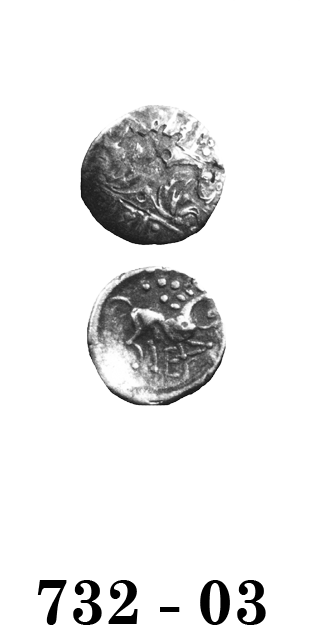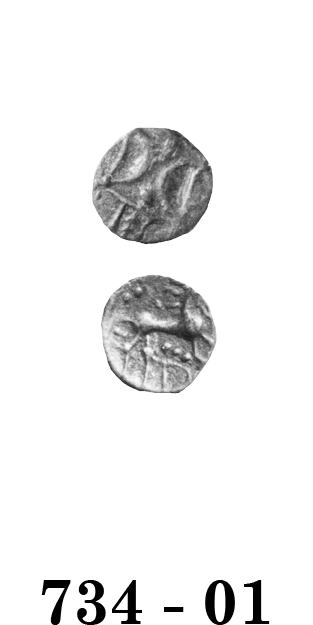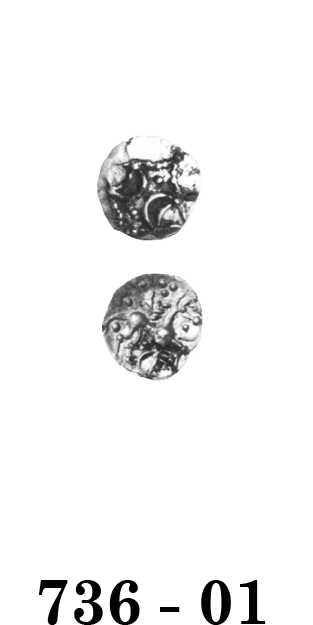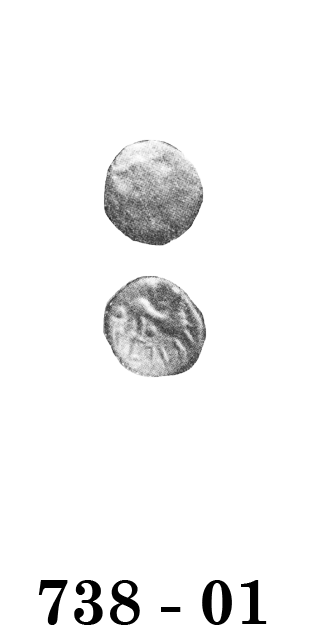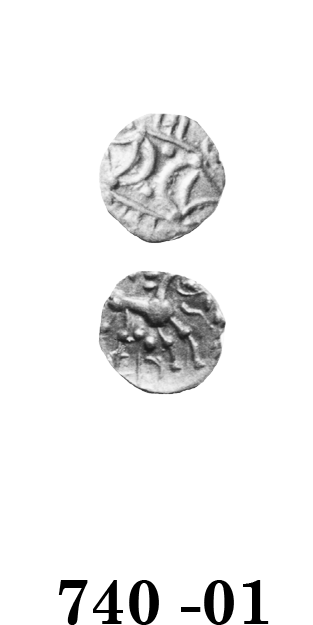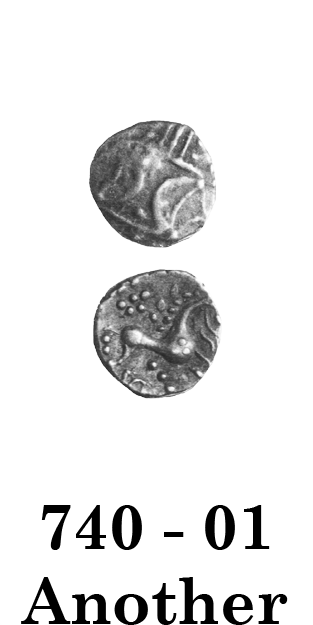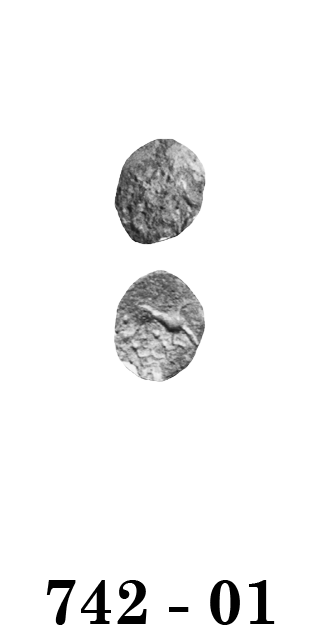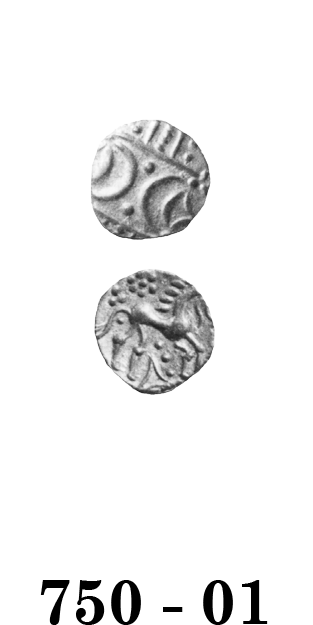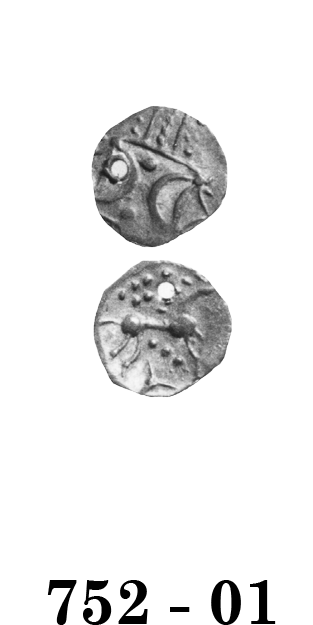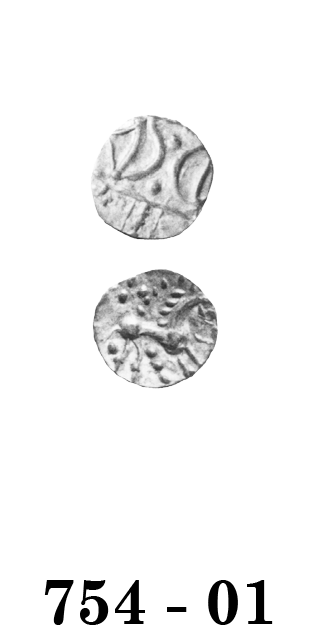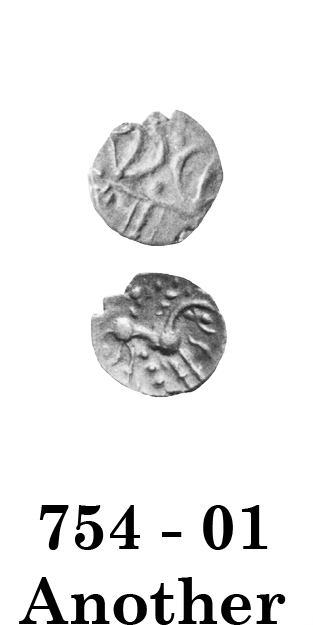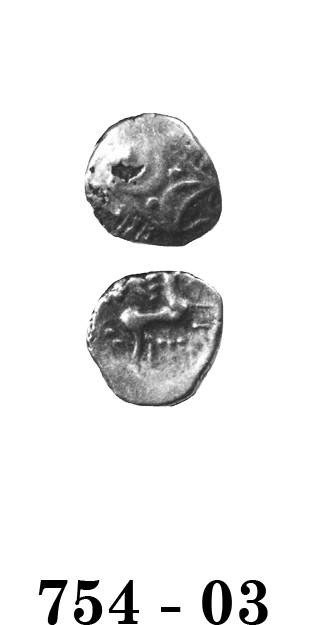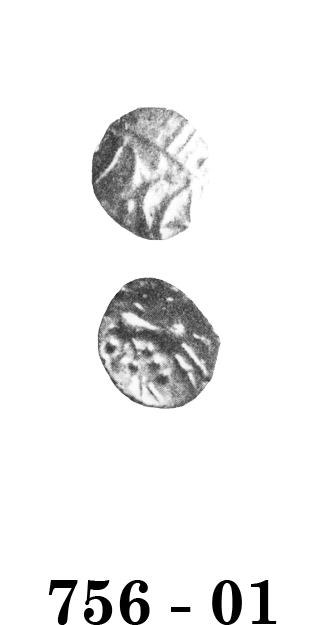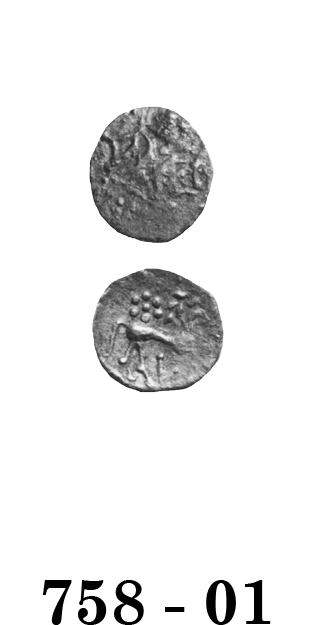
Celtic Coinage of Britain
third edition
Click on coin to see hidden information
Icenian Dynastic Coinages
At the end of the uninscribed coinages, an enigmatic coin appeared with the inscription CANI DURO. This may have been a local issue, or alternatively, the start of the dynastic issues.
The first certain dynastic issues start with the inscription ANTED, about 20 A.D. It is difficult to explain why the Iceni failed to inscribe their coins prior to this, possibly the Trinovantes/Catuvellauni exercised some influence over the tribe to prevent it. The coinage included a very small issue of gold staters and a large issue of silver units and fractions. ANTED is thought to be a personal name, or less likely, a title of a ruler.
Later, possibly around 35 A.D., coins inscribed ECEN appear. Again a very small issue of gold staters is accompanied with a large issue of silver units and fractions. ECEN is traditionally thought to be the name of the tribe, but is possibly the title or epithet of a ruler, instead.
Coins inscribed SAENV, AESV and ESV PRASTO ESICO FECIT appear at an uncertain date around the time of the ECEN coinage. Traditionally, the SUB ESVPRASTO coin was attributed to Prasutagus, but the interpretation has become much more complicated since 2000. The most recent thinking is that these three types are all somehow related.
A final group of uninscribed silver units starts sometime towards the end of the ECEN series and probably continues after the Claudian invasion. The very last of these coins are known only from the hoards of the Boudiccan Rebellion. These final types represent the coinage of Queen Boudicca, struck to finance the Icenian revolt of 61 A. D.
Coins Inscibed ECEN and variations of ECEN
The inscription ECEN, which appears in various forms, is traditionally thought to be the name of the tribe. One of the legs of the horse may supply the missing letter "I", completing the spelling "ECENI". At least one minor die variety is known, on which an added line may actually be the missing letter. Recently however, it has been suggested by Nash-Briggs the inscription could possibly be the title or epithet of a leader (but this suggestion does not seem to have met acceptance by the community of researchers).
An extensive series, on which the inscription is replaced by a symbol, occurs within the ECEN issues. Although a chronological placement of the sub-types has been suggested, based on typological analyses, John Talbot has now suggested an alternate arrangement. All of the types are now seen to be roughly contemporary, with three different die groups involved. The first, Mint Group A is seen as the primary group. This group is not indicated in the coin descriptions. Talbot suggests the Groups B and C could be struck at branch mints (controlled by the primary mint), or separate workshops within the main mint. Alternative interpretations would include Groups B and C as special-purpose coins struck, perhaps, intermittently, or as simply the work of different die-cutters. It is not possible to select a likely interpretation from these, and the issue remains unresolved. Groups B and C are indicated in the coin descriptions.
The overall chronology of the types is particularly difficult to determine. The issue starts after the ANTED series, possibly around 35 A.D. and ends sometime around the time of the Claudian Invasion of 43 A.D. However, it is also likely the output continued for some time after 43 A.D.
Previously, all ECEN coins accepted as genuine were either silver units or fractions. A plated coin made from a bronze core covered with a yellow metal, presumably gold, was offered for sale in 1980. This had a design similar to an ANTED stater but carried the inscription ECEN. Unfortunately, known Haslemere forgeries were offered simultaneously and although the coin in question has never been condemned it was not included in the 1989 catalogue. The catalogue now lists this plated core as 725 - 02. Sometime after 1990, normal gold staters inscribed ECEN started to appear, and these look to be genuine. They are listed here as 725 - 01.
A comment must be made about the rarity estimates for ECEN. In general, the coins are common, but there are some extremely rare types. Unfortunately, the records for these coins often fail to identify the exact variety, and opinion in the numismatic trade is divided – as a result the ratings in this section are likely to remain provisional.
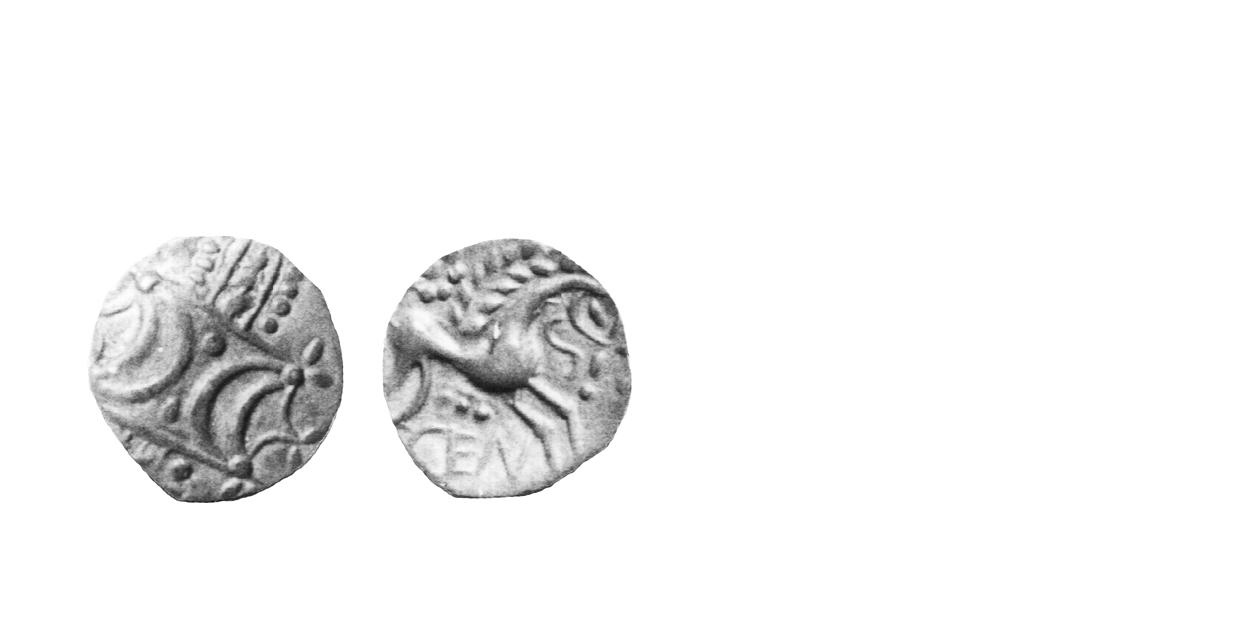
730 - 01 ECEN
35-43 A.D. Common
Silver Unit 1.25 gms. 14 mm
Earliest Record: Stukeley, 1776
OBV: Double crescent emblem
Identifying points:
1) two outline crescents back to back
2) two pellets between crescents
3) crescents between two parallel lines
4) lines and rows of pellets extend perpendicularly from the two lines
REV: Celticized horse right
Identifying points:
1) horse has outline head
2) daisy above horse
3) pellets below horse and under the tail
2) ECEN monogram under horse
CLASSIFICATION: Icenian H
NOTES:
- Many in museums
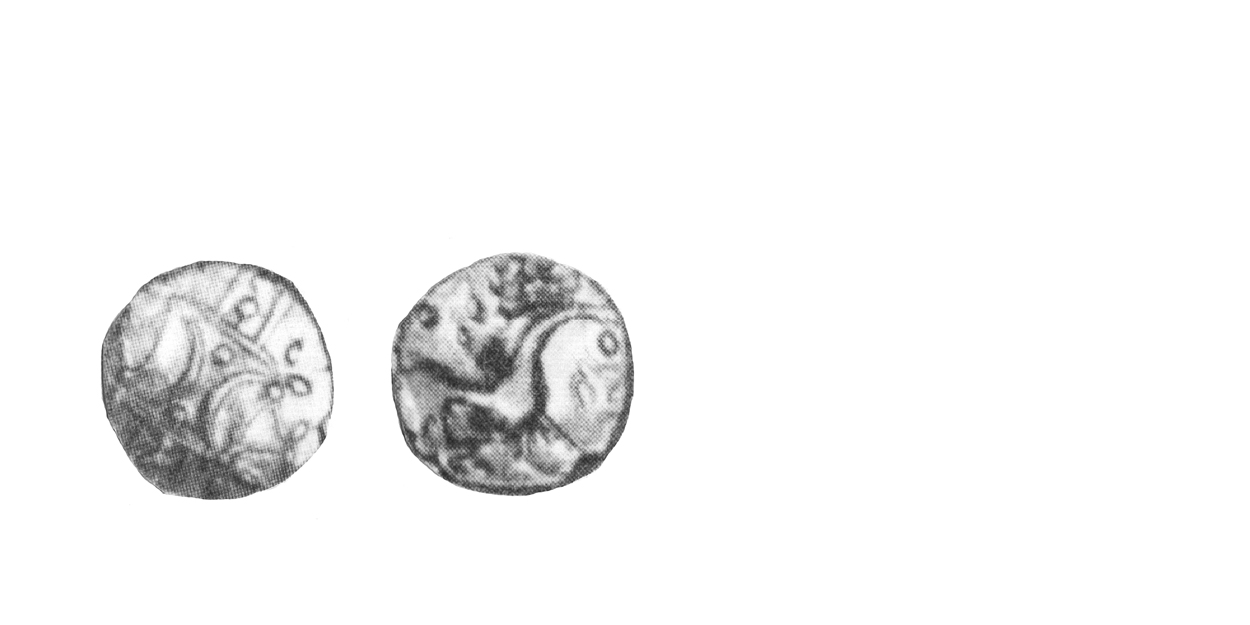
732 - 01 ECEN
35-43 A.D. Extremely Rare
Silver Unit 1.02 gms. 13 mm
Earliest Record: Allen, 1970
OBV: Double crescent emblem
Identifying points:
1) as 730 - 01
REV: Celticized horse right
Identifying points:
1) As 730 - 01 except for monogram under horse
2) monogram under horse simplified to just the letter E
CLASSIFICATION: Icenian H
NOTES:
- Weight and diameter given for illustrated coin
- Possibly commoner than indicated, type requires further study
- Existing example identified by Derek Allen, now in museum
- Discovery of an ancient plated forgery of this type suggests Allen was correct in identifying 732 - 01 as a separate type
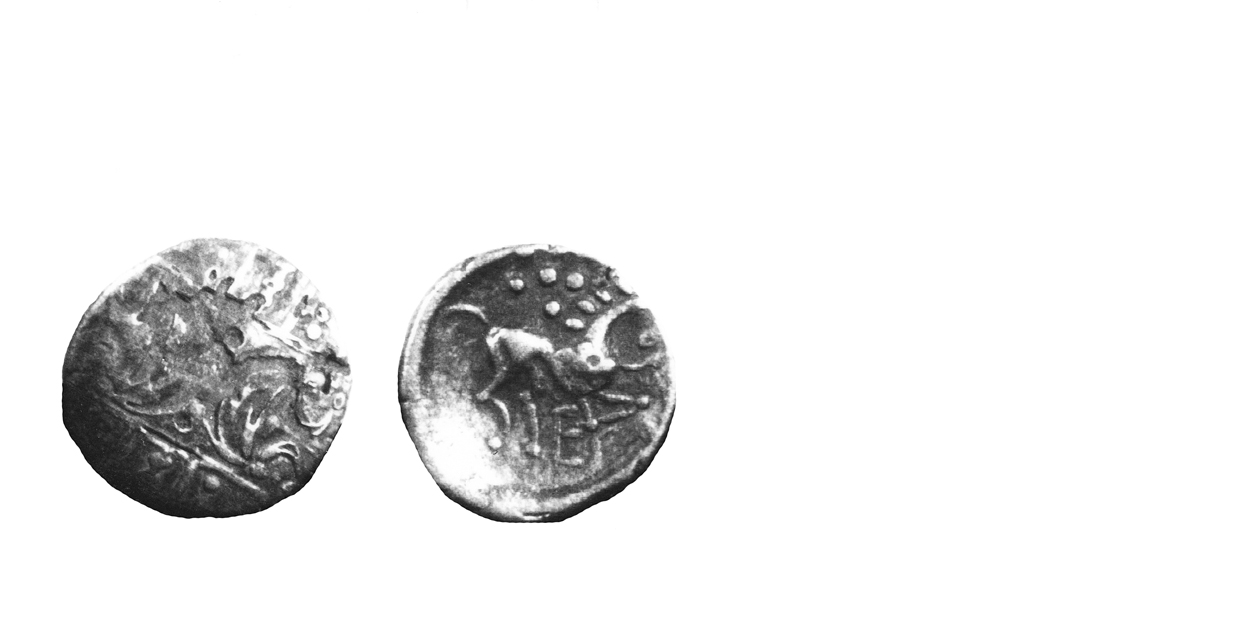
732 - 03 ECEN
35-43 A.D. Extremely Rare
Silver/Bronze Plated Unit 13 mm
Earliest Record: Van Arsdell, recorded 1991 (published 2013)
OBV: Double crescent emblem
Identifying points:
1) as 732 - 01
REV: Celticized horse right
Identifying points:
1) As 732 - 01
2) monogram under horse simplified to just the letter E
CLASSIFICATION: Icenian H
NOTES:
- Ancient forgery of 732 - 01
- Existence of this coin suggests Allen was correct in identifying 732 - 01 as a separate type
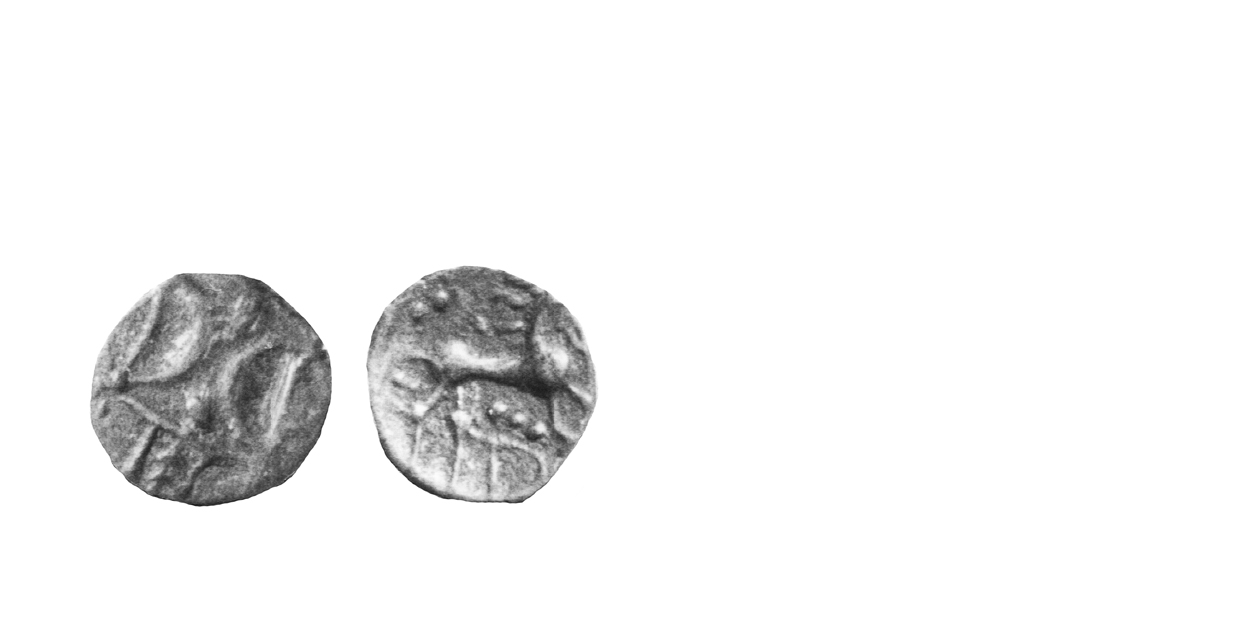
734 - 01 ECEN
35-43 A.D. Common
Silver Unit 1.25 gms. 12 mm
Earliest Record: Mack, 1964
OBV: Double crescent emblem
Identifying points:
1) as 730 - 01
REV: Celticized horse right
Identifying points:
1) As 730 - 01 except for monogram under horse
2) EDN monogram under horse
CLASSIFICATION: Icenian H
NOTES:
- Celtic Coin Index records now indicate this type is much commoner than thought
- Many in museums
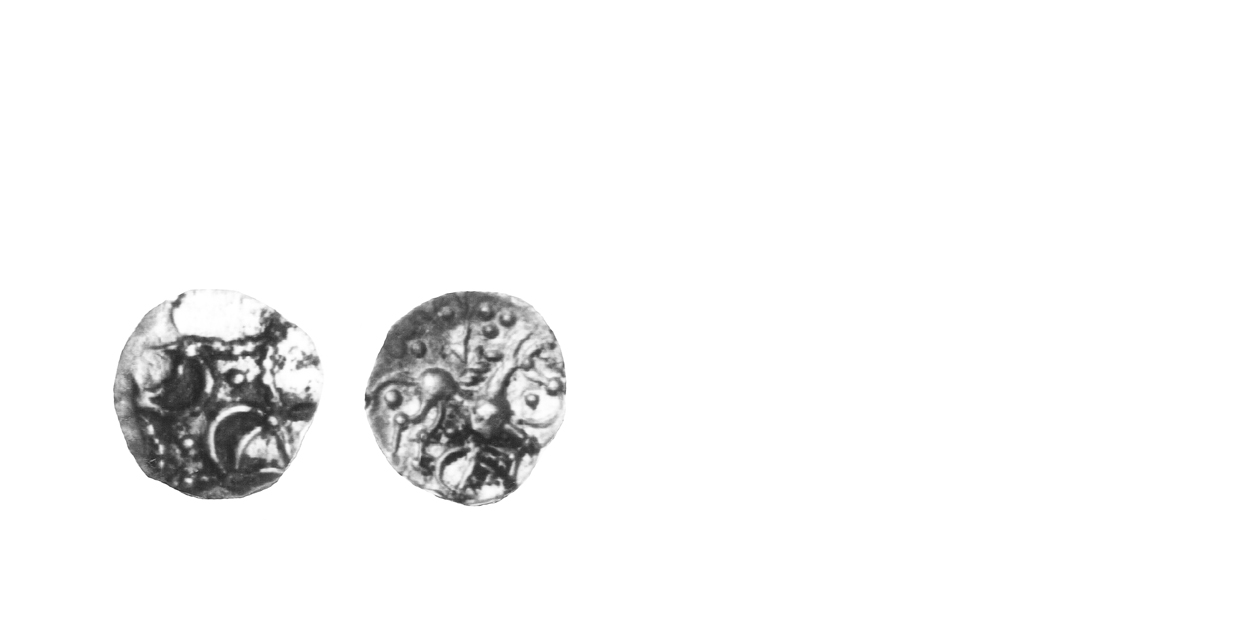
736 - 01 ECEN
35-43 A.D. Rare
Silver Fraction 0.4 gms. 1.1 mm
Earliest Record: Mack, 1953
OBV: Double crescent emblem
Identifying points:
1) two crescents back-to-back
2) two pellets between crescents
3) points of crescents connected by lines and rows of pellets to form triangles
REV: Celticized horse right
Identifying points:
1) horse has outline head
2) pellets around horse and below tail
3) ECE monogram below horse (letter N possibly off the flan on published examples)
CLASSIFICATION: Icenian H
NOTES:
- Celtic Coin Index records now confirm this type is commoner than thought
- Many in museums
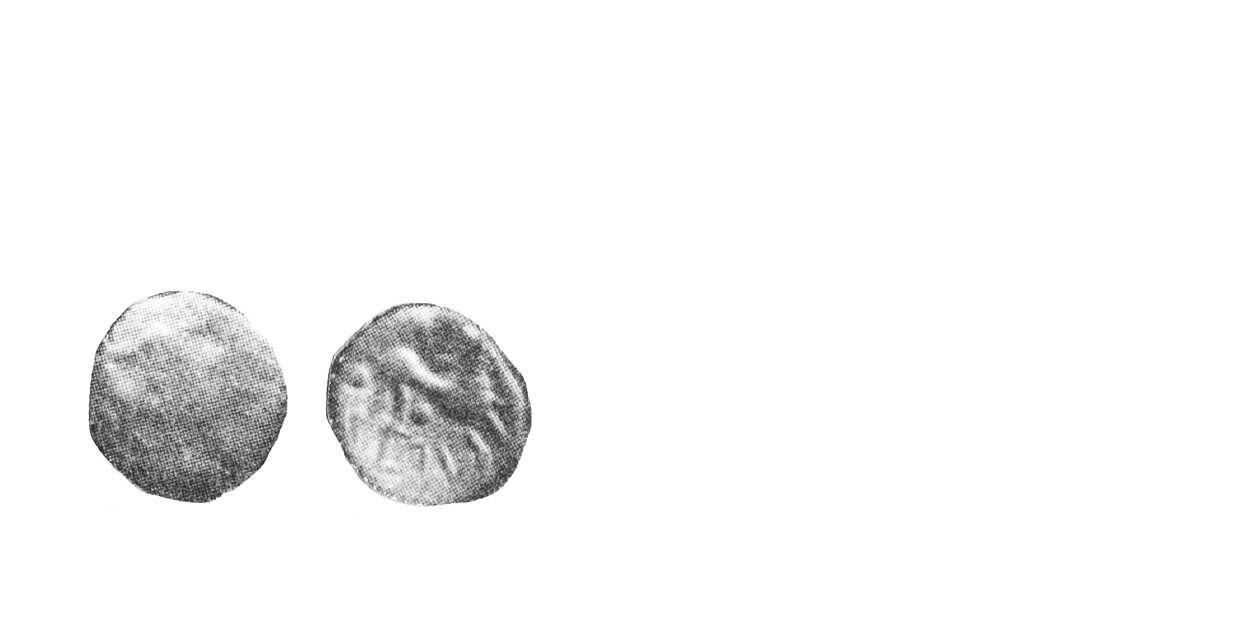
738 - 01 ECEN
35-43 A.D. Extremely Rare
Silver Fraction 0.5 gms. 1.1 mm
Earliest Record: Van Arsdell, 1989
OBV: Double crescent emblem
Identifying points:
1) as 736 - 01
REV: Celticized horse right
Identifying points:
1) as 736 - 01, except for monogram
2) ECN monogram under horse
CLASSIFICATION: Icenian H
NOTES:
- Celtic Coin Index records for this type continue to support rarity estimate
- Illustrated example in museum
- Weight and diameter given for illustrated example
- Existing example does not show the horse's head – presumed to be the outline head type
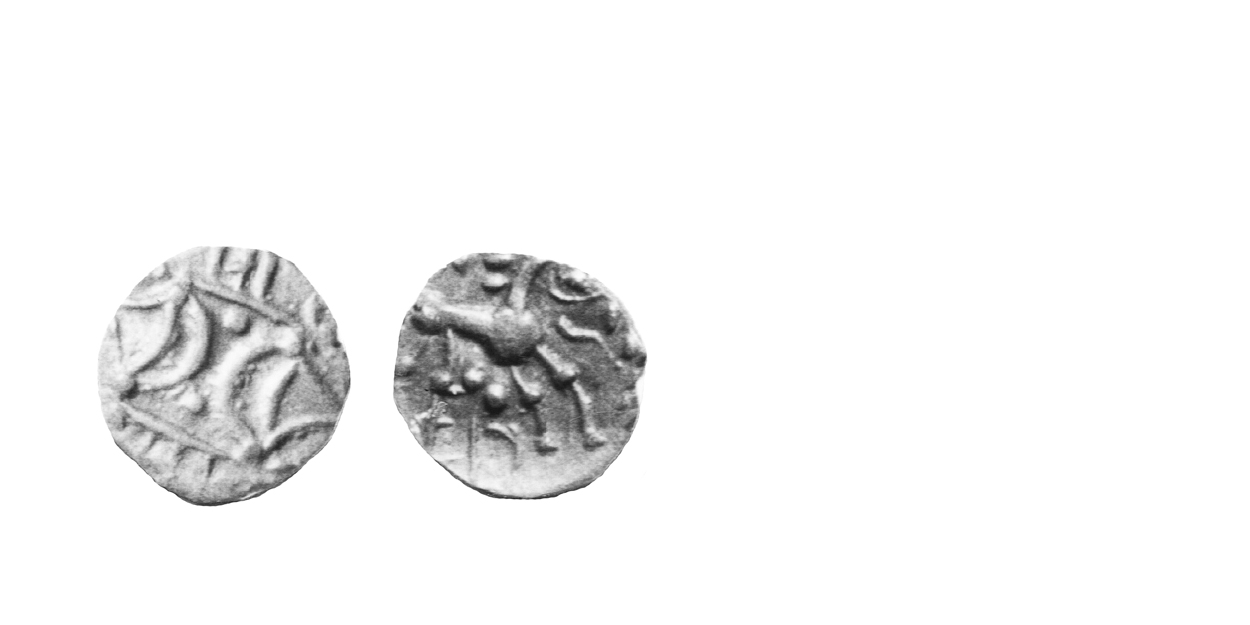
740 - 01 ECEN
35-43 A.D. Rare
Silver Unit 1.25 gms. 14 mm
Earliest Record: Stukeley, 1776
OBV: Double crescent emblem
Identifying points:
1) as 730 - 01
REV: Celticized horse right
Identifying points:
1) As 730 - 01 except for monogram under horse
2) ED monogram under horse
CLASSIFICATION: Icenian I
NOTES:
- Celtic Coin Index records now confirm commoner than originally thought
- Some in museums
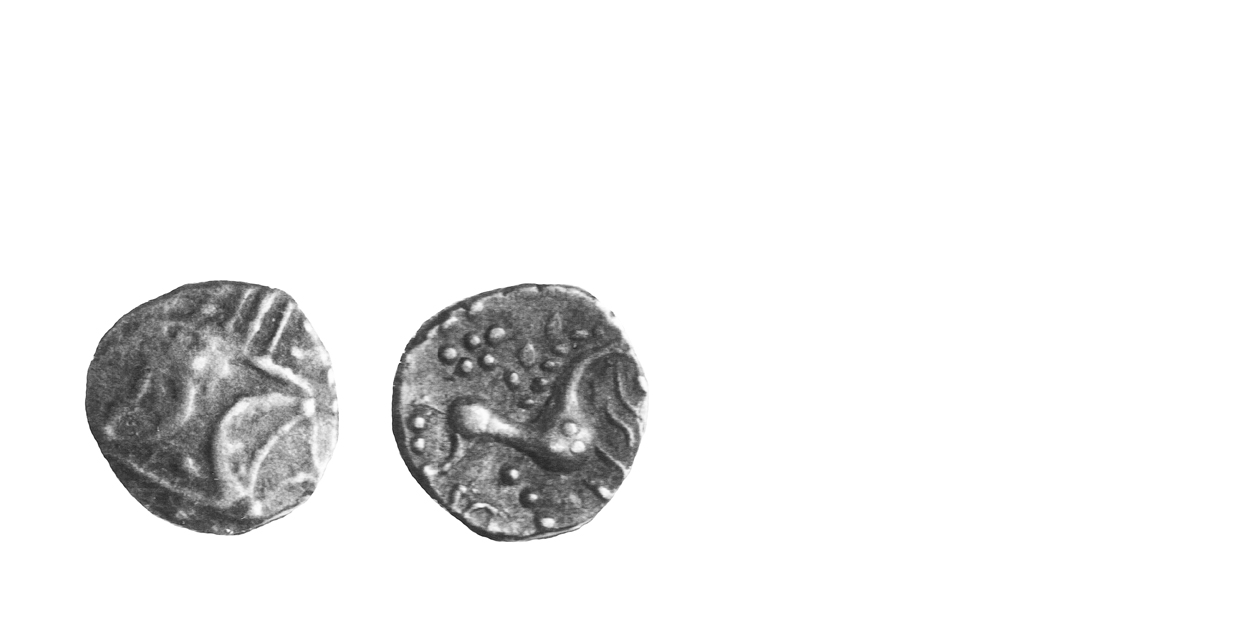
740 - 01 ECEN
35-43 A.D. Rare
Silver Unit 1.25 gms. 14 mm
Earliest Record: Stukeley, 1776
OBV: Double crescent emblem
Identifying points:
1) as 730 - 01
REV: Celticized horse right
Identifying points:
1) As 730 - 01 except for monogram under horse
2) ED monogram under horse
CLASSIFICATION: Icenian I
NOTES:
- Celtic Coin Index records now confirm commoner than originally thought
- Some in museums
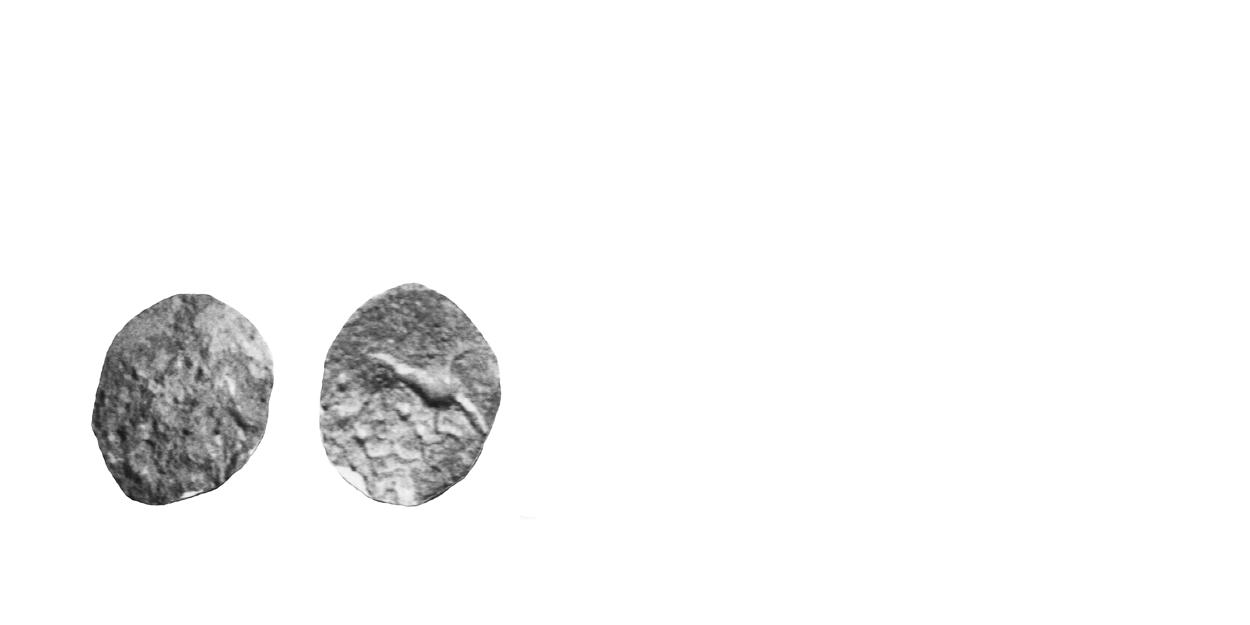
742 - 01 ECEN
35-43 A.D. Extremely Rare
Silver Fraction 0.4 gms. 11 mm
Earliest Record: Allen, 1970
OBV: Double crescent emblem
Identifying points:
1) as 736 - 01
REV: Celticized horse right
Identifying points:
1) as 736 - 01 , except for monogram under horse
2) ECE, EC or ECN monogram under horse
CLASSIFICATION: Icenian I
NOTES:
- Celtic Coin Index records continue to indicate rarity of this type
- Existing example in museum
- Allen, 1970 noted die varieties with ECE, EC and ECN inscriptions
744 - 01 Deleted
Allen, 1970 listed several uninscribed minims with similar ECEN types, but could not determine the relationship with the inscribed coins. 744 - 01 is now regarded as same type as 683 -01.
See 683-01
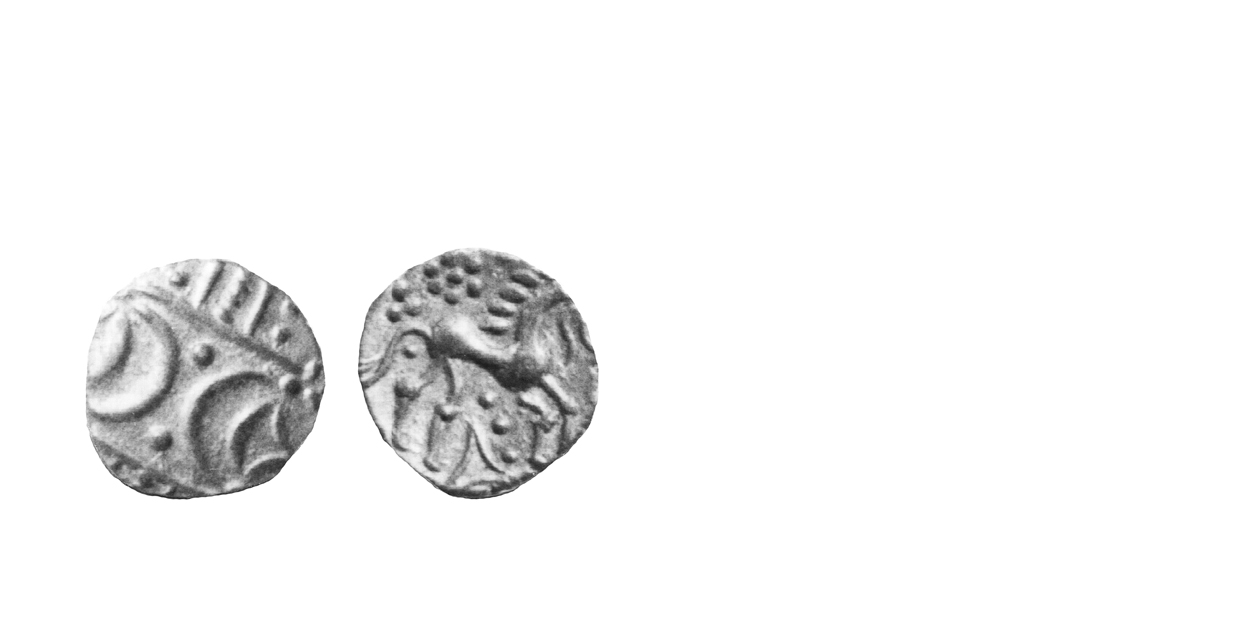
750 - 01 ECEN Symbol Type
35-43 A.D. Extremely Rare
Silver Unit 1.25 gms. 14 mm
Earliest Record: Stukeley, 1776
OBV: Double crescent emblem
Identifying points:
1) as 730 - 01
REV: Celticized horse right
Identifying points:
1) As 730 - 01 except for monogram under horse
2) monogram under horse replaced by a triangle
CLASSIFICATION: Icenian J
NOTES:
- Celtic Coin Index records continue to indicate this type to be extremely rare
- Most examples known are in museums
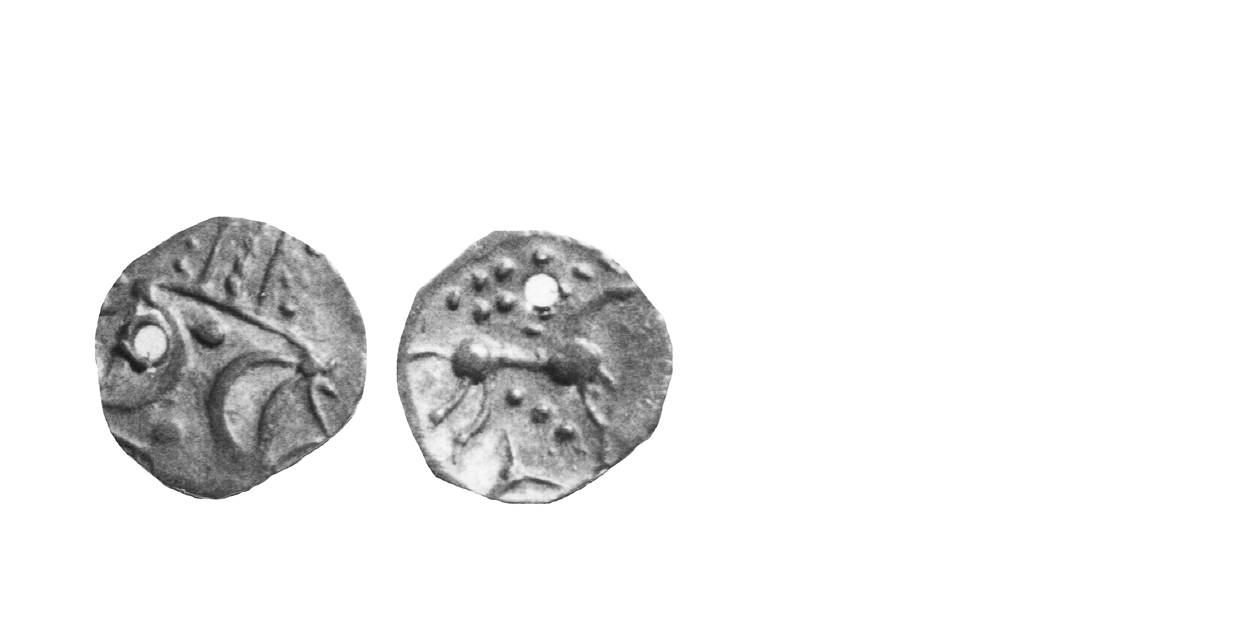
752 - 01 ECEN Symbol Type
35-43 A.D. Scarce
Silver Unit 1.25 gms. 14 mm
Earliest Record: Evans, 1864
OBV: Double crescent emblem
Identifying points:
1) as 730 - 01
REV: Celticized horse right
Identifying points:
1) As 730 - 01 except for monogram under horse
2) monogram under horse replaced by a Y made of three lines and a pellet
CLASSIFICATION: Icenian J
NOTES:
- Celtic Coin Index records now indicate this type is commoner than previously thought
- Some in museums
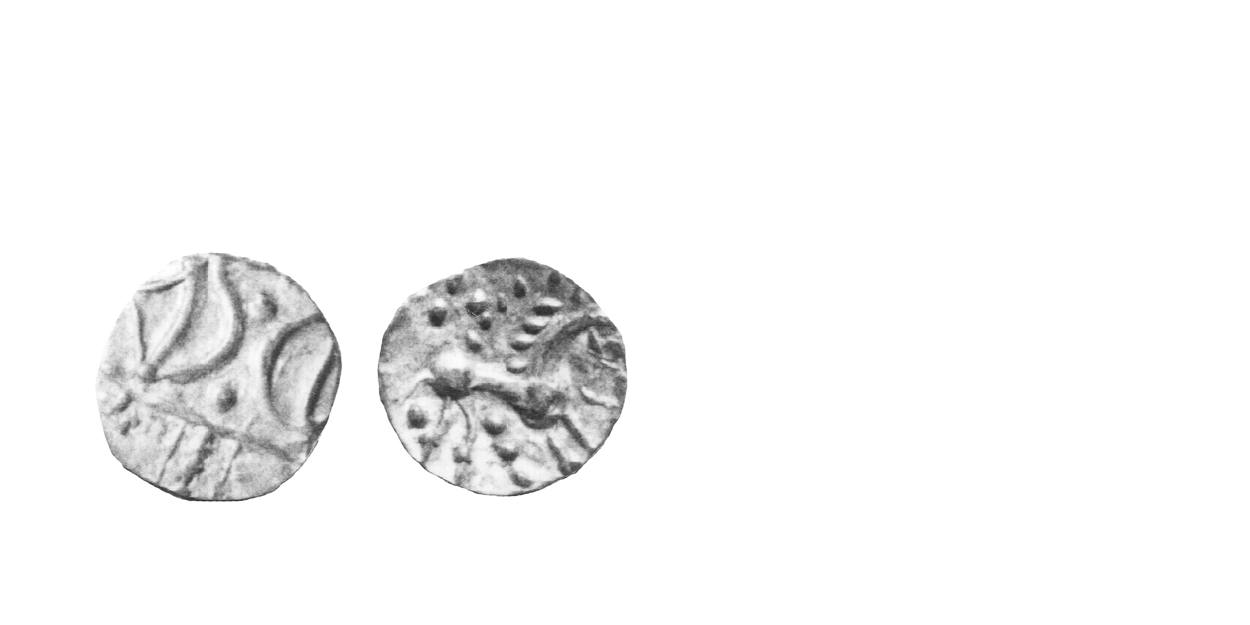
754 - 01 ECEN Symbol Type
35-43 A.D. Extremely Rare
Silver Unit 1.25 gms. 14 mm
Earliest Record: Allen, 1970
OBV: Double crescent emblem
Identifying points:
1) as 730 - 01
REV: Celticized horse right
Identifying points:
1) as 730 - 01 except for monogram under horse
2) monogram under horse replaced by three pellets in a line
CLASSIFICATION: Icenian J
NOTES:
- Inaccurate records for this type, probably commoner than indicated
- At least one known example in museum
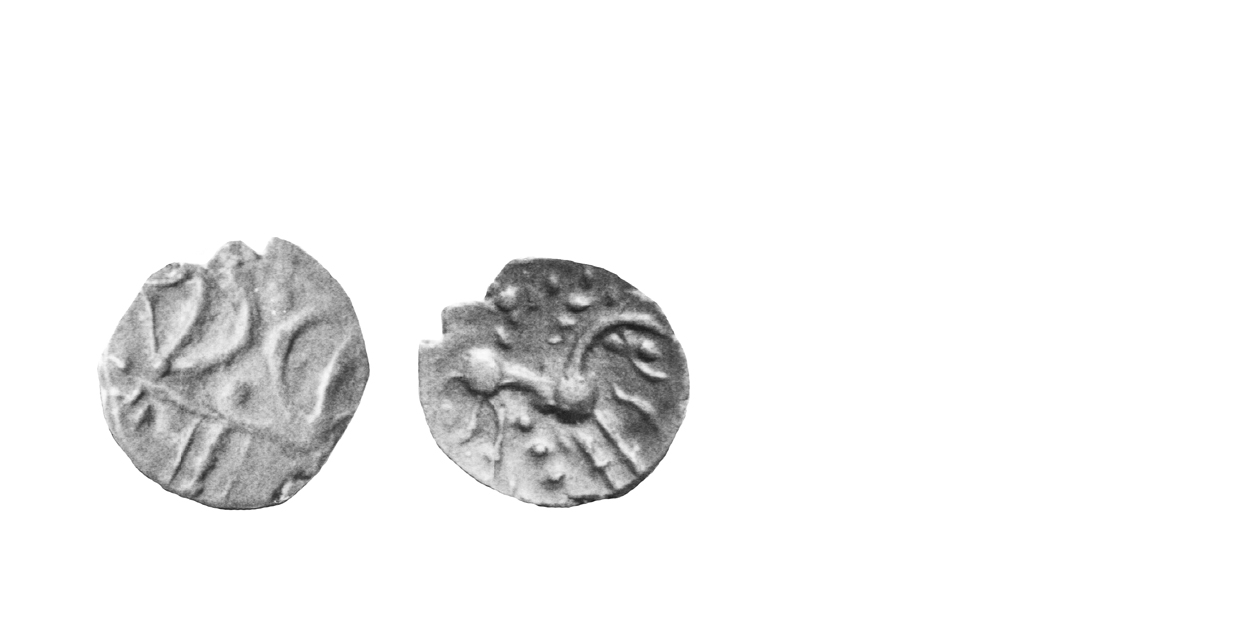
754 - 01 ECEN Symbol Type
35-43 A.D. Extremely Rare
Silver Unit 1.25 gms. 14 mm
Earliest Record: Allen, 1970
OBV: Double crescent emblem
Identifying points:
1) as 730 - 01
REV: Celticized horse right
Identifying points:
1) as 730 - 01 except for monogram under horse
2) monogram under horse replaced by three pellets in a line
CLASSIFICATION: Icenian J
NOTES:
- Inaccurate records for this type, probably commoner than indicated
- At least one known example in museum
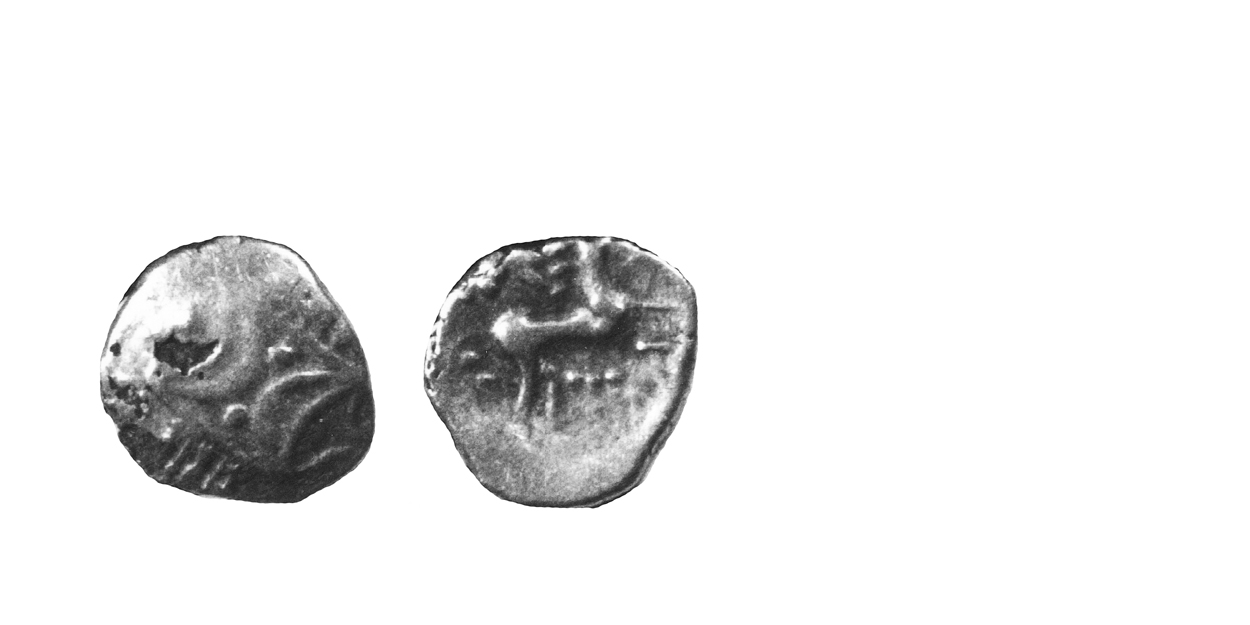
754 - 03 ECEN Symbol Type
35-43 A.D. Extremely Rare
Silver/Bronze Plated Unit 14 mm
Earliest Record: Van Arsdell, 1991 (not published)
OBV: Double crescent emblem
Identifying points:
1) as 730 - 01
REV: Celticized horse right
Identifying points:
1) as 730 - 01 except for monogram under horse
2) monogram under horse replaced by three pellets in a line
CLASSIFICATION: Icenian J
NOTES:
- Ancient forgery of 754 - 01
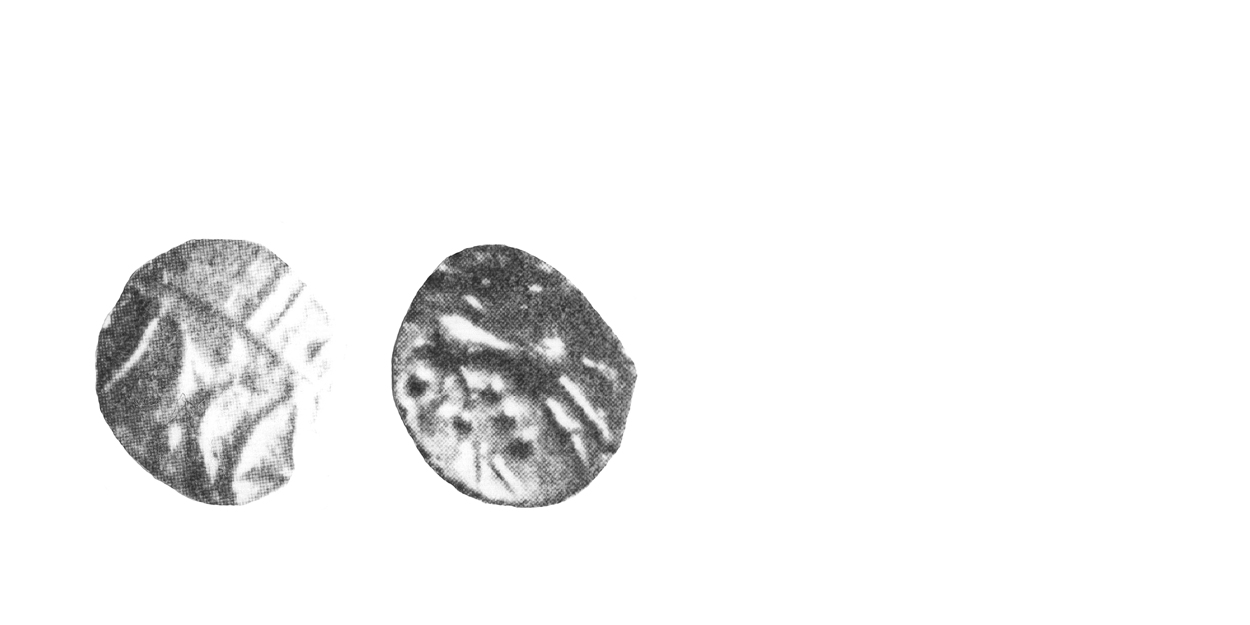
756 - 01 ECEN Symbol Type
35-43 A.D. Extremely Rare
Silver Unit 1.25 gms. 14 mm
Earliest Record: Allen, 1970
OBV: Double crescent emblem
Identifying points:
1) as 730 - 01
REV: Celticized horse right
Identifying points:
1) As 730 - 01 except for monogram under horse
2) monogram under horse replaced with three pellets
3) upside-down V near the three pellets
CLASSIFICATI()N: Icenian J
NOTES:
- Inaccurate records for this type, probably commoner than indicated
- Known example in museum
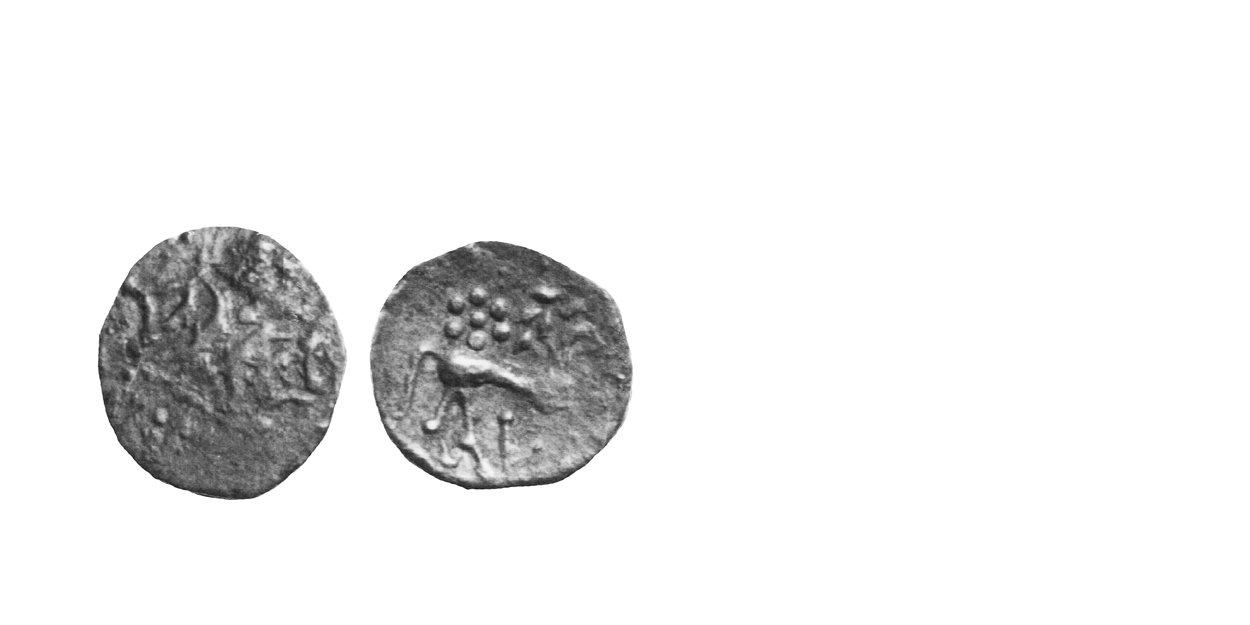
758 - 01 Symbol Type
35-43 A.D. Extremely Rare
Silver Unit 1.25 gms. 14 mm
Earliest Record: Mack, 1953
OBV: Double crescent emblem
Identifying points:
1) as 730 - 01
REV: Celticized horse right
Identifying points:
1) As 730 - 01 except for monogram under horse
2) monogram under horse replaced by a line with a pellet at the top
CLASSIFICATION: Icenian J
NOTES:
- Inaccurate records for this type, probably commoner than indicated
- Known example in museum
The Coinage of the Iceni
The Iceni occupied the area that is today Norfolk, Suffolk and parts of Cambridgeshire. Until the time of the Gallic War, the tribe seems economically isolated. Large Flan, Defaced Die and Abstract Design Type staters are not commonly found in Icenian territory, and presumably few were imported. Locally-made coins, the NORFOLK WOLF TYPE staters and BURY TYPE silver, were first produced late in the Gallic War. The earliest Icenian gold coinage comprises gold staters with the abstracted head of Apollo on the obverse and a disjointed wolf on the reverse. The heavy weight indicates the series began some time around the end of the war. After the war, the coins become quite debased and bronze cores of plated staters occur with some frequency. Later, a small coinage of SNETTISHAM TYPE coins were struck in gold and silver.
Apparently, extensive trading contacts developed during the war with the Trinovantes/Catuvellauni. A small number of Gallic War Type staters are found and uninscribed staters of the Trinovantes/Catuvellauni also appear. After the war, the coins of Addedomaros and Tasciovanus circulated. It is possible the Iceni relied on these imports instead of striking their own gold in volume.
About 20 B.C., the gold content of the Icenian coinage was restored with the introduction of the FRECKENHAM TYPE. Staters and quarters were struck lighter in weight to conform with the coinages of the other British tribes. The staters had a flower pattern or cross of pellets on the obverse and a Celticized horse on the reverse. Three major types occurred, described either as EARLIER and LATER, based on style and the progressive damage to one particular die linked with several others. Since all three types occurred in the Freckenham Hoard, it is likely they were contemporary.
After the war an extensive Icenian silver coinage was produced, which probably continued up to the time of the Boudiccan Rebellion. Silver units were produced to a standard weight of 1.25g. for nearly 100 years, a remarkable economic and technological achievement. There was a bewildering succession of types, subtypes and minor die varieties. These varieties have been systematically analyzed by John Talbot, and the arrangement is now reasonably certain. It appears that in any given period, three separate kinds of silver were being struck. Talbot suggests that the main Icenian mint either had two branch mints, or alternatively three workshops within a single mint. It is also possible that the different kinds of silver were either produced for different purposes, or perhaps at different times within a given period. Generally, the absolute chronology needs additional work. The chronology used here makes use of the work reported in John Talbot and Ian Leins's 2010 paper in The British Numismatic Journal.
The FRECKENHAM TYPE disappeared by 20 A.D. and the uninscribed silver coins were superseded by the dynastic. Very few inscribed gold coins are known. It is possible the gold coinage was minimal and the Iceni used silver coins augmented with Trinovantian/Catuvellaunian gold after 20 A.D. The Icenian dynastic period is largely one of a prolific silver coinage, beginning with the addition of an inscriptions to the CRESCENT TYPE and the introduction of the EMBLEM TYPE.
